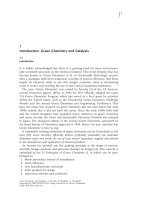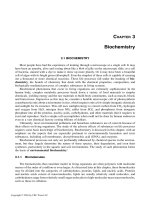Green Chemistry and Processes
Bạn đang xem bản rút gọn của tài liệu. Xem và tải ngay bản đầy đủ của tài liệu tại đây (1.61 MB, 343 trang )
Green Chemistry
and Processes
This page intentionally left blank
Green Chemistry
and Processes
Mukesh Doble
Professor, Department of Biotechnology,
India Institute of Technology, Madras, India
Anil Kumar Kruthiventi
Associate Professor, Department of Chemistry
Sri Sathya Sai University, India
AMSTERDAM • BOSTON • HEIDELBERG • LONDON
NEW YORK • OXFORD • PARIS • SAN DIEGO
SAN FRANCISCO • SINGAPORE • SYDNEY • TOKYO
Academic Press is an imprint of Elsevier
Academic Press is an imprint of Elsevier
30 Corporate Drive, Suite 400, Burlington, MA 01803, USA
525 B Street, Suite 1900, San Diego, California 92101-4495, USA
84 Theobald’s Road, London WC1X 8RR, UK
This book is printed on acid-free paper.
Copyright © 2007, Elsevier Inc. All rights reserved.
No part of this publication may be reproduced or transmitted in any form or by any
means, electronic or mechanical, including photocopy, recording, or any information
storage and retrieval system, without permission in writing from the publisher.
Permissions may be sought directly from Elsevier’s Science & Technology Rights
Department in Oxford, UK: phone: (+44) 1865 843830, fax: (+44) 1865 853333,
E-mail: You may also complete your request online via the
Elsevier homepage (), by selecting “Support & Contact” then
“Copyright and Permission” and then “Obtaining Permissions.”
Library of Congress Cataloging-in-Publication Data
Application submitted
British Library Cataloguing-in-Publication Data
A catalogue record for this book is available from the British Library.
ISBN: 978-0-12-372532-5
For information on all Academic Press publications visit our
Web site at www.books.elsevier.com
Printed in The United States of America
07 08 09 10
9 8 7 6 5 4 3
2
1
Working together to grow
libraries in developing countries
www.elsevier.com | www.bookaid.org | www.sabre.org
Dedications
I would like to dedicate this book to Geetha, Deepak, and Niharika.
—Mukesh
I would like to dedicate this book to Bhagawan Sri Sathya Sai Baba.
—Anil Kumar
This page intentionally left blank
Contents
Preface
About the Authors . . .
xi
xv
1
Introduction
Definition of Green Chemistry
Twelve Principles of Green Chemistry
Initiatives Taken Up by Countries Around the World
The Green Chemistry Expert System
How Green Chemistry Is Being Addressed
Cross Interactions from Green Chemistry
The Patent Scene
The Measure of Greenness
Safety and Risk Indices
Mass and Energy Indices
The Hierarchical Approach
The Sustainable Process Index
Conclusions
References
1
3
3
6
7
9
9
11
11
15
16
17
21
22
23
2
Newer Synthetic Methods
Introduction
Use of Microwaves for Synthesis
Electro-Organic Methods
Elegant and Cost-Effective Synthetic Design
Conclusions
References
27
27
32
33
33
37
39
vii
viii
Contents
Appendix 2.1
References
Appendix 2.2
References
40
42
44
50
3
Catalysis and Green Chemistry
Catalysis and Green Chemistry
Conclusions
References
53
54
66
66
4
Biocatalysis: Green Chemistry
Introduction
Advantages Within Industrial Applications
Challenges to Make Biocatalysis Industrially Viable
Process Design
Future Trends
References
69
69
70
71
82
83
89
5
Alternate Solvents
Safer Solvents
Green Solvents
Water as Solvent
Solvent-Free Conditions
Ionic Liquids
Conclusions
References
93
94
97
98
99
99
103
104
6
Process and Operations
Industry Perception
Reactions
Reactor Designs
Micro Mixers
Unit Operations
Reactions with Separation Operations
Other New Reactor Designs
Process Integration
Conclusions
References
105
107
112
113
117
121
135
161
162
167
168
7
Alternate Energy Sources
Greenhouse Gases
Renewable Energy
Future Sources of Renewable Energy
171
172
187
190
Contents ix
Conclusions
References
190
191
8
Inherent Safety
Conflicts Due to Inherently Safe Designs
Conclusions
References
193
228
242
243
9
Industrial Examples
The Pharmaceutical Industries and Green Chemistry
The Polymer Industry
Pesticides, Antifoulants, and Herbicides
Solvents and Green Chemistry
The Food and Flavor Industry
The Maleic Anhydride Manufacturing Process
Chelants
The Surfactant Industry
Industries in Need of Support to Go Green
The Semiconductor Manufacture Industry
The Dye Industry
The Textile Industry
The Tannery Industry
The Sugar and Distillery Industries
The Paper and Pulp Industry
The Pharmaceutical Industry
Conclusions
References
245
252
264
270
274
277
280
281
283
284
284
285
286
288
288
289
291
293
294
Conclusions and Future Trends
Energy
Process Intensification
Biotechnology: The Solution to All Problems
Future Predictions
Conclusions
References
297
297
299
302
308
310
311
10
Index
313
This page intentionally left blank
Preface
After the Second World War, industrialization took place at a tremendous pace without giving any thought to its effects on the
environment, flora and fauna, and peoples’ safety and heath. This
led to increased global warming, depletion of ozone protective
cover from harmful UV radiation, contamination of land and water
ways due to release of toxic chemicals by industries, reduction in
nonrenewable resources such as petroleum, destructions of forest
cover due to acid rains, increased health problems, and industrial
accidents resulting in loss of life and property.
The Kyoto Protocol is an international treaty bringing almost
180 nations of the world together in an effort to limit greenhouse
gas emissions and reduce the effects of global warming. The reduction is expected to be achieved through industrial green house gas
reduction (42%), use of renewable energy (22%), methane reduction from live stock and other sources (22%), energy efficiency
(12%), and fuel switch from oil to natural gas (2%). The United
States and Australia rejected the treaty and had refused to sign it
even as late as November 2006. The EU-15 countries had agreed
to cut, by 2012, 8% of the 1990 greenhouse gas emissions values,
but the data collected by the European Commission (Oct. 2006)
predicted that the values would be only 0.6%. Worse still, many
European countries may even exceed their individual limits.
Industries are interested in green chemistry because reduction
in energy, improvement in yield, and use of cheaper raw materials
lead to reduction in working capital and an increase in profits.
Industries are also interested in improving the safety, health, and
xi
xii
Preface
working conditions of their workforce, because they are worried
about litigations and pressures from NGO and other employee
unions. Incremental improvements in processes are easily implementable, while major changes in processes require changes in
equipment and hardware; therefore the manufacturing industries
hesitate to undertake such a huge capital expenditure. Process
intensification also requires scrapping the old equipment and using
new equipment, which industries are hesitant to undertake due
to expenditure. Alternate energy sources are still not as competitive as the petroleum-based energy. Although a few applications
are found in the use of renewable energy, the latter has not
made major inroads. Waste treatment is seen as a wasteful
activity and industries are beginning to comply with government
pollution bodies. On the other hand, preventing or reducing waste
at the source through design of innovative processes is much
more profitable for them. While industries weigh all actions with
respect to profit and cost reduction, it is the duty of the government to take the larger view and weigh the long-term benefits to
society. Unless the governments are committed nothing can be
achieved.
Green chemistry involves reduction and/or elimination of the
use of hazardous substances from a chemical process. This includes
feedstock, reagents, solvents, products, and byproducts. It also
includes the use of sustainable raw material and energy sources
for this manufacturing process. This book is an interdisciplinary
treatise dealing with chemistry and technology of green chemistry.
Measuring “greenness” has always been a challenge and there are
different approaches discussed here. Comparing various processes
based on a set of common standards is discussed. Novel and innovative synthetic techniques that lead to reduction of raw material/solvent usage, milder operating conditions, less wasteful side
products, etc., are discussed in Chapter 2. Heterogeneous catalysts
provide mild and efficient environment. They are superior to
methods that use stoichiometric amounts of chemical reagents or
homogeneous catalysts since they produce minimum waste and
side products. Examples of processes that use biocatalysts are discussed in detail in Chapter 4. Biocatalysts simplify reactions, telescope multiple steps into one and make it environmentally clean
and friendly. Even reactions which cannot be performed with
chemical synthesis can be carried out with ease using microbes.
New solvents such as ionic liquids are becoming very popular
since they are benign, environmentally friendly, and do not contribute toward voc. This book does not discuss the research that
Preface
xiii
is in progress to identify new reagents which are mild and those
that do not produce waste.
Miniaturization and innovative reactor designs have led to an
increase in mass and heat transfer coefficients by several orders of
magnitude, reduced reaction time dramatically, eliminated waste,
and improved safety. Chapter 6 covers the approaches followed by
manufacturers to achieve process miniaturization and intensification, decrease multistep reaction to single step, and combine reaction with unit operation. Use of membranes and other novel
downstream processing techniques are also discussed.
Hydrocarbon fuel is a non-renewable source of energy and it
is well accepted that it would not last long. Research using alternate energy sources is being pursued seriously in many research
labs worldwide. Use of renewable raw material includes ethanol,
biodiesel, etc. Biomass appears to be the future energy source in
addition to solar, wind, and wave.
Processes that are milder (i.e., use less toxic solvents, do not
produce dangerous intermediates, recalcitrant waste, or side
product chemicals, etc.) are inherently safe. Such a philosophy
could have prevented Bhopal. The principle of green chemistry
believes in designing inherently safe processes. Industries that are
seriously taking an all-out effort to decrease waste, improve efficiency, and decrease energy are discussed in Chapter 9. The final
chapter deals with the future trends and frontier research in this
area. Process improvements will never end. Biotechnology will
play a crucial part in achieving the goals of green chemistry.
Unless the politicians and administrators in countries of the world
realize the importance of green chemistry and the urgency with
which it has to be approached, the world will deteriorate into an
uninhabitable mass of land.
I would like to thank Ms. N. Aparnaa for her secretarial help
during the preparation of the manuscript.
Mukesh Doble
December 2006
This page intentionally left blank
About the Authors . . .
MUKESH DOBLE is a Professor at the Department of Biotechnology, Indian Institute of Technology, Madras, India. He has authored
110 technical papers, four books, filed three patents, and is a
member of the American and Indian Institute of Chemical Engineers. The recipient of the Herdillia Award from the Indian Institute of Chemical Engineers, he received his B.Tech. and
M.Tech. degrees in chemical engineering from the Indian Institute
of Technology, Madras, and a Ph.D. degree from the University of
Aston, Birmingham, England. He has postdoctoral experience from
the University of Cambridge, England and Texas A&M University,
USA. He has worked in the research centers of ICI India and GE
India for 20 years.
ANIL KUMAR KRUTHIVENTI is an Assistant Professor, Department of Chemistry, Sri Sathya Sai University, India. The author
of 40 technical papers, he has filed two patents in microbial mediated o-dealkylations of aryl alkyl ethers and is a member of the
Indian Science Congress. He is the recipient of the Young Teachers
Career Award (1996) from the All India Council for Technical
Education, New Delhi, India. He received his M.Sc. and Ph.D.
degrees from Sri Sathya Sai University, Prashanti Nilayam, A.P.
India.
xv
This page intentionally left blank
CHAPTER 1
Introduction
The chemical industry accounts for 7% of global income and 9%
of global trade, adding up to US$1.5 trillion in sales in 1998, with
80% of the world’s output produced by 16 countries. Production
is projected to increase 85% by 2020 compared to the 1995 levels.
This will be in pace with GDP growth in the United States, but
at twice the per capita intensity. There will be strong market penetration by countries other than these 16, especially in commodity
chemicals (OECD, 2001). Over the past half-century, the largest
growth in volume of any category of materials has been in petrochemical-based plastics; and in terms of revenue it was pharmaceuticals. The latter, in the past two decades, has become number
one. Overall production has shifted from predominantly commodity chemicals to fine and specialty chemicals, and now it is the
life sciences. In the United States, the chemical industry contributes 5% of GDP and adds 12% of the value to GDP by all U.S.
manufacturing industries, and it is also the nation’s top exporter
(Lenz and Lafrance, 1996). This information speaks volumes about
the importance of chemical industries in our day-to-day life and
in supporting the nation’s economy. But it is plagued with several
problems, such as running out of petrochemical feedstock, environmental issues, toxic discharge, depletion of nonrenewable
resources, short-term and long-term health problems due to exposure of the public to chemicals and solvents, and safety concerns,
among others.
About 7.1 billion pounds of more than 650 toxic chemicals
were released to the environment in 2000 by the United States
1
2
Green Chemistry and Processes
Minimum
packaging
Minimum
energy
One step
Simple
separation
safe
Ideal
product
Renewable
resources
Ideal
process
Atomefficient
Zero
waste
Recyclable
reusable
Environmental
acceptability
safe
100%
biodegradable
100 % yield
Minimum
usage
Care for
ecology
Ideal
user
Understand
impact of
all products
on environment
recycle
reuse
FIGURE 1.1. Criteria for ideal product, process of manufacture and
user.
alone (Environmental Protection Agency, 2002, www.epa.gov).
This inventory represents only a small fraction of the approximately 75,000 chemicals in commercial use in the United States.
The health and environmental effects of many chemicals are not
known completely, even though some have been in use for several
decades. The U.S. industry spends about $10 billion per year on
environmental R&D. An ideal manufacturing process and an ideal
product should have certain criteria, which are depicted in Fig. 1.1.
An ideal process is simple, requires one step, is safe, uses renewable resources, is environmentally acceptable, has total yield, produces zero waste, is atom-efficient, and consists of simple
separation steps. An ideal product requires minimum energy and
minimum packaging, is safe and 100% biodegradable, and is recyclable. Generally, the public focuses on the process and product,
paying very little attention to the “ideal user.” Figure 1.1 also lists
an ideal user. An ideal user cares for the environment, uses minimal
amounts, recycles, reuses, and understands a product’s environmental impact. In addition, an ideal user encourages “green”
initiatives.
Introduction 3
Definition of Green Chemistry
Green chemistry involves a reduction in, or elimination of, the use
of hazardous substances in a chemical process or the generation of
hazardous or toxic intermediates or products. This includes feedstock, reagents, solvents, products, and byproducts. It also includes
the use of sustainable raw material and energy sources for this
manufacturing process (Anastas and Warner, 1998; Anastas and
Lankey, 2000, 2002; Anastas et al., 2001). A responsible user is also
required to achieve the goals of green chemistry. The U.S. Presidential Green Chemistry Challenge, March 1995, defines green chemistry as,
the use of chemistry for source reduction or pollution prevention,
the highest tier of the risk management hierarchy as described
in the Pollution Prevention Act of 1990. More specifically, green
chemistry is the design of chemical products and processes that are
more environmentally benign.
Green and sustainable chemistry, a new concept that arose in
the early 1990s, gained wider interest and support only at the turn
of the millennium. Green and sustainable chemistry concerns the
development of processes and technologies that result in more
efficient chemical reactions that generate little waste and fewer
environmental emissions than “traditional” chemical reactions
do. Green chemistry encompasses all aspects and types of chemical processes that reduce negative impacts to human health and
the environment relative to the current state-of-the-art practices
(Graedel, 2001). By reducing or eliminating the use or generation
of hazardous substances associated with a particular synthesis or
process, chemists can greatly reduce risks to both human health
and the environment.
Twelve Principles of Green Chemistry
The 12 principles of green chemistry are listed below (Clark and
Macquarrie, 2002). Of course, over the years additional principles
have been added to these original 12, but those could be derived
from these 12 principles.
1. Prevention. It is better to prevent waste than to treat or clean
it up after it has been generated in a process. This is based on
the concept of “stop the pollutant at the source.”
4
Green Chemistry and Processes
2. Atom economy. Synthetic steps or reactions should be designed
to maximize the incorporation of all raw materials used in the
process into the final product, instead of generating unwanted
side or wasteful products (Trost, 1991, 1995).
3. Less hazardous chemical use. Synthetic methods should be
designed to use and generate substances that possess little or
no toxicity to the environment and public at large.
4. Design for safer chemicals. Chemical products should be
designed so that they not only perform their designed function
but are also less toxic in the short and long terms.
5. Safer solvents and auxiliaries. The use of auxiliary substances
such as solvents or separation agents should not be used whenever possible. If their use cannot be avoided, they should be
used as mildly or innocuously as possible.
6. Design for energy efficiency. Energy requirements of chemical
processes should be recognized for their environmental and
economic impacts and should be minimized. If possible, all
reactions should be conducted at mild temperature and
pressure.
7. Use of renewable feedstock. A raw material or feedstock should
be renewable rather than depleting whenever technically and
economically practicable. For example, oil, gas, and coal are
dwindling resources that cannot be replenished.
8. Reduction of derivatives. Use of blocking groups, protection/
de-protection, and temporary modification of physical/
chemical processes is known as derivatization, which is
normally practiced during chemical synthesis. Unnecessary
derivatization should be minimized or avoided. Such steps
require additional reagents and energy and can generate waste.
9. Catalysis. Catalytic reagents are superior to stoichiometric
reagents. The use of heterogeneous catalysts has several advantages over the use of homogeneous or liquid catalysts. Use of
oxidation catalysts and air is better than using stoichiometric
quantities of oxidizing agents.
10. Design for degradation. Chemical products should be designed
so that at the end of their function they break down into
innocuous degradation products and do not persist in the environment. A life-cycle analysis (beginning to end) will help in
understanding its persistence in nature.
11. Real-time analysis for pollution prevention (Wrisberg et al.,
2002). Analytical methodologies need to be improved to allow
for real-time, in-process monitoring and control prior to the
formation of hazardous substances.
Introduction 5
less
processes
safe
process
chemicals
efficient
energy
solvents
Prevent
waste
solvents
Raw
materials
catalyst
waste
Sustainable/
renewable
Realtime
pollution
monitor
No
derivatives
degrade
FIGURE 1.2. Key words in 12 principles of green chemistry.
12. Inherently safer chemistry for accident prevention. Substances
and the form of a substance used in a chemical process should
be chosen to minimize the potential for chemical accidents,
including releases, storage of toxic chemicals, explosions, and
fires.
Five main foci emerge from these 12 principles (see Fig. 1.2),
namely
1.
2.
3.
4.
5.
less,
safe,
process-oriented,
waste-reducing,
sustainable.
All five key words could be grouped around this, as shown in
Fig. 1.2:
1. Uses fewer chemicals, solvents, and energy.
2. Has safe raw materials, processes, and solvents.
3. Process should be efficient, without waste, without derivatization, and should use catalysts.
4. Waste generated should be monitored in real time and should
degrade.
5. All chemicals, raw materials, solvents, and energy should be
renewable or sustainable.
6
Green Chemistry and Processes
As can be seen from the figure, the key words are interrelated
at the lower level. By focusing on the five key words during process development, one could achieve the philosophy of green
chemistry.
Initiatives Taken Up by Countries Around the World
In the United States, President Clinton announced the Presidential
Green Chemistry Challenge in March 1995. The program included
research grants, educational activities, and annual green chemistry
awards to highlight the topic and encourage companies and
researchers to focus on green chemistry. Later, in the United
Kingdom, the Green Chemistry Network was established. In Italy,
Germany, and Australia, similar activities were initiated. Many
international organizations, such as the Organization for Economic
Cooperation and Development (OECD), the International Union
of Pure and Applied Chemistry (IUPAC), the European Chemical
Industry Council (CEFIC), and the Federation of European Chemical Societies (FECS), also adopted green and sustainable chemistry
as part of their agenda. The European Environmental Agency
established a European Green and Sustainable Chemistry Award.
Green chemistry is being pushed by the EPA (USA) because it
meets the agency’s mission of protecting human health and the
environment. It is also being promoted by the National Science
Foundation (USA) as part of its mission to support and promote
innovative, basic scientific research. The Department of Energy
(DOE, USA) is involved in green chemistry programs because
it expects that the country will benefit from increased energy
efficiency and reductions in global warming pollutants. India’s
Department of Science and Technology (DST) and the Science and
Engineering Research Council (SERC) actively sponsor and fund
research by academia and industries in the area of green chemistry
and processes, especially the academic–industry collaboration
(IChemE, 2003).
The Maastricht Treaty states that those who are responsible
for environmental pollution, resource depletion, and social cost
should pay the full cost of their activities. If these costs are ultimately passed on to the consumer, then there is an incentive to
reduce the levels of environmental damage and resource depletion.
For example, discharge of industrial waste from a manufacturing
operation into a water course results in a downstream user’s incurring extra costs to treat and purify it. Unless there is government
Introduction 7
pressure, the upstream manufacturer does not have to pay the full
cost of its operation, and it will get away with creating the damage.
Problems created by industries several decades ago are surfacing now, creating serious health problems to the public. In such
cases the government has to bear the cost of cleanup (e.g., “super
funds”).
Green chemistry has introduced several new terms and new
research frontiers, including “eco-efficiency,” “sustainable chemistry,” “atom efficiency or economy,” “process intensification and
integration,” “inherent safety,” “product life-cycle analysis,” “ionic
liquids,” “alternate feedstock,” and “renewable energy sources.”
Eco-efficiency is the efficiency with which ecological resources
are used to meet human needs. It includes three scientific focus
areas needed to achieve eco-efficiency. The three focuses, which
are the same in the United States and Australia, are the use of
alternative synthetic pathways, the use of alternative reaction
conditions, and the design of chemicals that are less toxic than
current alternatives or the design of inherently safer chemicals
with regard to accident potential.
Great Britain’s Royal Society of Chemistry publishes an international scientific journal entitled Green Chemistry bimonthly;
the first issue was published in February 1999. The majority of the
synthesis and process journals focus on papers related to this
topic.
The Green Chemistry Expert System
The Green Chemistry Expert System (GCES) developed by the
EPA ( allows
users to build a green chemical process, design a green chemical,
or survey the field of green chemistry. The system is useful for
designing new processes based on user-defined input. The various
features of GCES are contained in five modules:
1. The “Synthetic methodology assessment for reduction techniques” (SMART) module quantifies and categorizes the hazardous substances used in or generated by a chemical reaction.
2. The “Green synthetic reactions” module provides technical
information on green synthetic methods.
3. The “Designing safer chemicals” module includes guidance
on how chemical substances can be modified to make them
safer.
8
Green Chemistry and Processes
4. The “Green solvents/reaction conditions” module contains
technical information on green alternatives to traditional
solvent systems. Users can search for green substitute solvents
based on physicochemical properties.
5. The “Green chemistry references” module allows users to
obtain toxicity and other data about a large number of chemicals and solvents.
The interest in the field of green chemistry is growing dramatically, motivated as much as by economic as by environmental
concerns. Faced with rising environmental costs, litigation,, and
pressures from environmental groups, institutions now recognize
that more efficient processes leading to bottom-line energy and
environmental savings are necessary. Legal and societal pressures
are increasing as a result of today’s increased scrutiny of the chemical businesses, increased medical bills due to long-term exposure
to toxic chemicals, and the environmental impacts these businesses cause (see Fig. 1.3). For example, the chemical industry’s
response to the Montreal Protocol in quickly innovating benign
alternatives to ozone-depleting compounds demonstrates its ability
to respond quickly to environmental challenges. Many companies
have already replaced their ozone-depleting CFCs with milder
chemicals.
Although exposure reduction may reduce risk at a cost, it does
nothing to address consequences should there be a failure in the
controls. Green chemistry, based in hazard reduction, reduces or
eliminates risk at the source—and hence reduces the consequences.
Green chemistry can address toxicological and waste generation
Inefficient processes
Generation of large waste
Poor atom efficiency
Increased
competition
Identify renewable
energy sources
Excess usage of nonrenewable resources
Discharge waste
without treating
Identify renewable
resources
Improve process efficiency
Recycle waste
Time
1950-60
Insufficient knowledge of
effect of chemicals on
health and environment
2000
More knowledge of
effect of chemicals on
health and environment
Discharge waste
after treating
Process
intensification
Pressure from
Govt. & NGO
Zero
discharge
Inherent
safety
Biotransformation
& Fermentation
FIGURE 1.3. Changes taking place in the philosophy of process development by industries.









